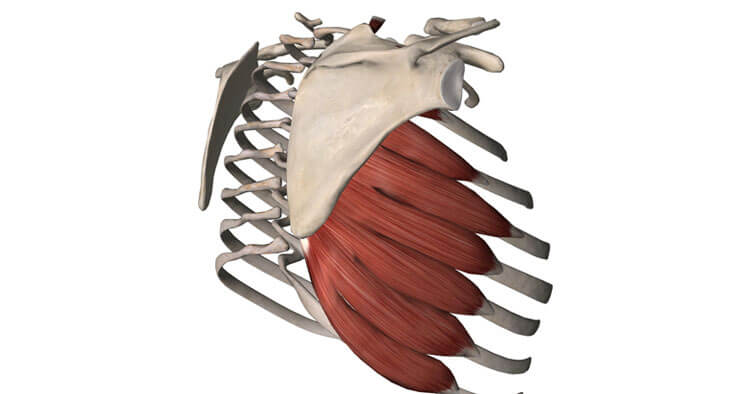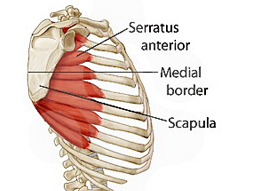Back and Joint Pain, Muscle Pain and Tendinopathy
Serratus Anterior And A Winged Scapula
Causes Of A Winged Scapula
In most cases of winged scapula that we see in our Randwick and Sydney physio practices, the serratus anterior muscle is the main culprit. The serratus anterior muscle attaches to the medial (inside) border of the shoulder blade and sweeps across the side of the shoulder blade between the shoulder blade and the ribs before insertion into the lateral aspect to the ribcage. When working as intended the serratus anterior anchors the scapula against the rib cage when at rest, throughout movement and when the upper limbs take load, fixing the scapula snugly up against the chest wall . When serratus anterior contracts, it works to help cause upward rotation, abduction, and elevation of the shoulder blade movements which assist in allowing your arm to be raised above your head. Basically it pulls the shoulder blade up and around the chest wall, assisting in keeping the ball and the socket lined up as the arm moves outwards and upwards.
Weakness of serratus anterior causes the scapula to slip away from being tucked up against the rib cage, and the inside border of the scapula fans out giving it the wing-like appearance on the upper back, known as winged scapula. Weakness of serratus anterior can occur as the result of damage or impingement to the nerve that innervates the muscle. The long thoracic nerve is the motor nerve to the serratus anterior muscle and is suggested to be prone to injury due to the long and superficial path it travels. Damage to this nerve has a number of potential causes being of both traumatic (for example, following a dislocated shoulder) and non traumatic origin (such as following viral infection).
Other than damage to the nerve supplying serratus anterior, some suggested potential causes of a winged scapula include:
- Brachial plexus injury
- Shoulder instability
- Palsy or weakness of other stabilizing muscles of the scapula
- Rotator cuff pathology
Diagnosing A Winged Scapula
Presentation of a winged scapula may be quite subtle and more challenging to pick up, or be blatantly obvious and relatively easy to diagnose with the naked eye. Even when obvious and the scapula is protruding out and visibly winging, this does not however tell you “why” the shoulder blade is winging. Physical examination and at times the use of investigations such as: standard x-rays, MRI of the shoulder, neck, or scapula as well as electromyography (EMG) testing of affected nerves and muscles may be performed to isolate the exact nerve/s and muscle/s involved. Understanding which muscles and nerves are involved and uncovering the underlying cause of the winging is vital when looking to address the scapula dysfunction and create a tailored rehabilitation plan.
Winging Scapular At Sydney Physio Clinic
In our Sydney physio practice it is common to see scapular dyskinesis, a condition where the shoulder blade moves abnormally. This condition is usually due to muscle imbalances causing the altered scapulohumeral rhythm. Scapular dyskinesis may be caused through a number of factors including:
- Poor posture
- Shoulder injury
- Overuse of the shoulders in employment, hobbies, or sports
- Injury to the muscles of the scapular
- Rotator cuff pathology
- Pain in the shoulder
Scapular dyskinesis is usually responsive to physiotherapy treatment that works to address muscle imbalances and the underlying causes of the abnormal movement pattern of the shoulder blade. Noting that as mentioned above pain can cause altered movement patterns causing scapular dyskinesis and physiotherapy treatment that assists in relieving pain in some circumstances will see any compensatory movements of the shoulder blade resolve. A weak serratus anterior and subsequently some mild winging of the scapula is a common feature with abnormal scapulohumeral rhythm and physiotherapists would often prescribe some targeted serratus anterior strengthening exercises to improve the control and strength of the muscle if assessed as being weak. However, true scapular winging as a result of nerve damage to the long thoracic nerve or other nerve palsy’s are both more visually striking and functionally disabling. Fortunately nerve injury is far less common than adaptive weakness and as a result this type of winging scapula presents more inconsistently to our Randwick or CBD physio clinics.
Disclaimer: Sydney Physio Clinic does not endorse any treatments, procedures, products mentioned. This information is provided as an educational service and is not intended to serve as medical advice. Anyone seeking specific orthopaedic advice or assistance on Serratus Anterior And A Winged Scapula should consult his or her general practitioner, sports medicine specialist, physiotherapist or otherwise appropriately skilled practitioner.




I suspect i have a winged scapula in my left side. If i decide to initiate a treatment i want to know how would you proceed, what’s the program for me and for how long it will go approximately.
Thanks.
Hi Marc, it is difficult to say as it depends the cause of the winging regarding if it is due to nerve injury, structural spinal changes like a scolosis, or weakness and postural changes related to soft tissues around the shoulder. Happy to have you come in and assess if you wish simply let us know and we can arrange an appointment with one of our physios, should be able to give you a good idea of what is involved after that.
Hy it’s me Rabindra ghimire I am
Suffering from wing scapula at left side but right shoulder is down comparatively down and I did whole body mri but docoter said nothing and he gave me muscle Madicin but I am felling right part is down how to do I have to surgery or what
Hi Rabindra
Regardless that they are a very sensitive investigation often the causes of a winging scapula (or a SICK scapula) will not be able to be seen on an MRI. However in saying that it is good news that the scan is clear and some of the causes will have been ruled out. I think seeing your local physiotherapist is probably a good next move for you taking the scan report along with you and see what that have to suggest prior to considering surgery.
Is there possible to surgery of wing scapula at australia which hospital is best please sir can you suggest it gonna effect on socolisis
Assessing the impact of winging scapula on scoliosis or vice versa is difficult without actually seeing someone again as previously mentioned seeing your local physio is probably a good idea. There are many great surgeons in Sydney and Australia wide which surgeon you would choose and is surgery is appropriate really depends on the cause and severity and functional impact of your winging scapula so really your local physio is still ideally a great starting point for helping provide information regarding this.
Long thoracic nerve decompression surgury is good or not
Pt please it is effective
Give me an appointment for me see your my body and refer to best dr for long thoracic nerve decompression surgury with good doctor please